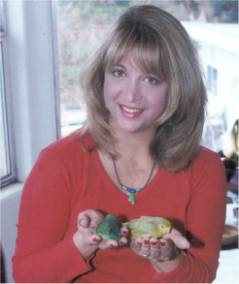Sandee-
I read that the blue mutation of Pacific Parrotlets have gentler dispositions than original greens, and that the yellow Pacifics are particularly feisty. Do you find that the color mutations have any identifiable personalities traits linked to them? Or do you think people are taking experience from maybe one or two Parrotlets they have known, and making a generalized statement?
Thanks for your help,
Kathleen
Dear Kathleen:
Thank you so much for your email. This is an excellent question and I really appreciate you asking it.
I’ve kept and bred parrotlets for almost 30 years and have bred hundreds and seen thousands. I preface my answer with that fact because I do believe the less birds you have the more ‘sure’ you are of their behavior. The longer you keep birds and the more you have, you realize that they are all individuals and that, just like with people or dogs, you can’t make generalizations about individuals based on generic information. Most people who have a bird and its sweet will make that statement about all of them that are like that. If you have a blue or a dilute (formerly yellow) and it’s a wonderful bird, it is human nature to attribute its pet quality on physical characteristics. That really isn’t true. The best pet birds are the ones who personalities lend themselves to enjoy the company of humans, whether or not they have been strongly imprinted (i.e., ‘socialized’), how they are trained and how they are kept. Those things have a far greater influence on behavior than species, sex or color.
I do believe that is part of why people think that certain mutations are ‘sweeter’ than normal birds (although good luck trying to find any Pacific parrotlet that doesn’t have some mutation gene in its background). However, I do have a theory that mutations are often considered ‘sweeter’ because in the wild they do not survive long enough to develop much of a survival instinct. They are aberrations of Nature and it is inherent in Nature to have survival of the fittest. A blue or yellow parrotlet is going to stick out like a sore thumb in a place that has predominantly green foliage and therefore are much easier to prey upon than a normal green parrotlet. That is if the parents don’t kill them when they are in the nest. Therefore, I don’t believe these birds survive long enough to either develop a more aggressive nature which is needed to survive in the harsh environment where Pacific parrotlets are found nor do I believe they have much of an opportunity to breed even if they make it to maturity. After all, in the wild, like breeds with like. If you are green, you are not going to gravitate naturally to a yellow or blue bird. Nature doesn’t design birds that way – if so, hybridization would be rampant in the natural world. In captivity, of course, those instincts go out the window when mature, adult, healthy birds of the opposite sex are paired together. Just ask anyone who has a male and a female as pets and they end up breeding. Nature designed the need to perpetuate the species first and foremost.
So, to answer your question, I don’t believe, based on my experience, that color mutations per se are sweeter or make better pets. I just believe the statement is attributed to human interpretation of a very limited personal experience and the fact that Nature didn’t give these guys the instinct needed to survive in the wild. That doesn’t make them ‘sweeter’ it just makes them less inclined to use survival skills (like biting) when being handled.
Hope this makes sense and thanks again for the question.
Sincerely yours,
Sandee L. Molenda, C.A.S.
The Parrotlet Ranch, Owner, www.parrotletranch.com
Join the International Parrotlet Society, – the World’s Largest and Oldest Parrotlet Organization www.internationalparrotletsociety.org
A Chattering Bird Builds No Nest.
Camaroonian Phrase
Subscribe to:
Post Comments (Atom)




No comments:
Post a Comment
Note: Only a member of this blog may post a comment.